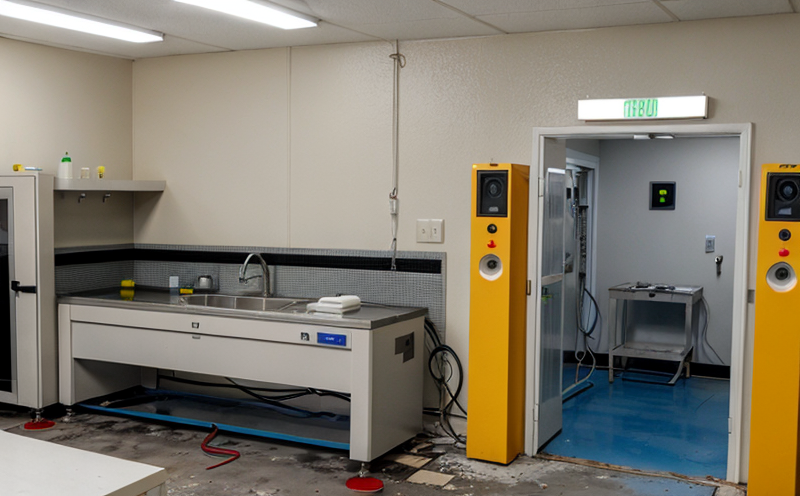ISO 11665-8 Radon Surface Contamination Monitoring
The ISO 11665-8 standard provides a comprehensive framework for monitoring radon surface contamination, which is crucial in ensuring the safety and compliance of facilities that handle radioactive materials. This service ensures that organizations can meet regulatory requirements while protecting personnel from unnecessary radiation exposure.
Radon surface contamination refers to the presence of radionuclides on surfaces, which can pose significant health risks if not properly managed. The ISO 11665-8 standard is particularly important in sectors such as nuclear power plants, research facilities, and hospitals where radioactive materials are used or stored.
The service involves a series of steps that begin with the identification of contamination sources. This can include personnel, equipment, and environmental factors that could lead to radon surface contamination. Once identified, the next step is to collect samples from potentially contaminated areas using appropriate sampling techniques. The chosen methods must ensure accurate representation of the contamination levels.
Following sample collection, the specimens are analyzed in our state-of-the-art laboratory facilities. Our team uses advanced instrumentation and analytical techniques to determine the presence and concentration of radon isotopes on the surfaces. This process is critical for ensuring that no unsafe levels of radiation are present before personnel or equipment are exposed.
The results of these analyses are then meticulously reported, providing a clear picture of any contamination issues. Our reports include detailed information about the methods used, the findings, and recommendations for corrective actions if necessary. This transparency ensures that facilities can take appropriate measures to address any contamination issues promptly.
Our expertise in this field allows us to provide accurate and reliable results, ensuring compliance with international standards such as ISO 11665-8. We understand the importance of this service in maintaining a safe working environment and contributing to overall radiation safety.
Scope and Methodology
| Step | Description | Method |
|---|---|---|
| Identification of Contamination Sources | Determine potential sources of radon surface contamination. | Review facility operations, personnel movements, and equipment usage. |
| Sampling Collection | Collect samples from identified areas using appropriate techniques. | Use Swabs or wipes for surface sampling. |
| Step | Description | Method |
|---|---|---|
| Analysis and Reporting | Analyze samples using advanced instrumentation. | Use Gamma Spectrometry for isotopic analysis. |
| Compliance Verification | Ensure results meet ISO 11665-8 standards. | Compare findings with international benchmarks. |
The methodology outlined in ISO 11665-8 is strictly followed to ensure accurate and reliable results. The use of gamma spectrometry for isotopic analysis allows us to identify the specific radionuclides present, providing a detailed understanding of contamination levels.
Our compliance verification process ensures that all findings are in line with international standards, offering peace of mind to our clients regarding their radiation safety practices.
Quality and Reliability Assurance
The quality and reliability of the ISO 11665-8 Radon Surface Contamination Monitoring service are paramount to our organization. We employ rigorous quality control measures at every stage of the process, from sample collection to final reporting.
Our team is trained in the latest techniques and uses only the most advanced instrumentation available. This ensures that we can provide accurate results consistently across all projects. Our commitment to quality is further demonstrated through our adherence to international standards such as ISO 11665-8.
We also maintain a robust quality management system, which includes regular audits and continuous improvement processes. These measures ensure that our service remains at the forefront of radiation safety practices, providing reliable data for decision-making.
Our clients can trust us to deliver accurate, timely results that meet all regulatory requirements. This level of reliability is crucial in maintaining a safe working environment and ensuring compliance with international standards.
Environmental and Sustainability Contributions
The ISO 11665-8 Radon Surface Contamination Monitoring service plays a vital role in promoting environmental sustainability. By identifying and managing radionuclide contamination, we help to minimize the risk of radiation exposure to personnel and the environment.
This service contributes to sustainable practices by ensuring that facilities operate within safe limits according to international standards. It helps prevent the spread of contaminated materials, which can lead to unnecessary environmental hazards.
Our commitment to sustainability extends beyond just monitoring contamination; we also work closely with clients to develop strategies for reducing radioactive waste and improving overall radiation safety protocols.
The use of advanced instrumentation and analytical techniques ensures that our service is both efficient and effective. By providing accurate data, we enable facilities to make informed decisions that contribute positively to environmental sustainability.





